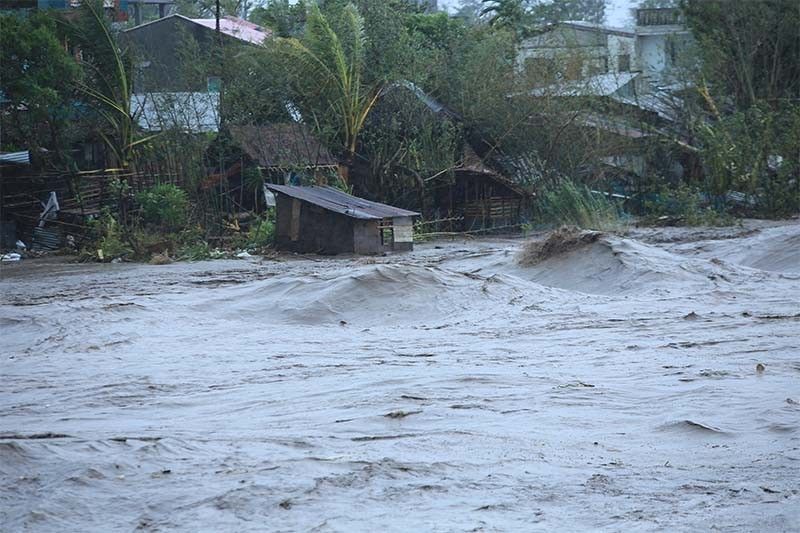Metro Manila was spared by 'Rolly,' then 'Ulysses' came

MANILA, Philippines (UPDATE 3:30 p.m., Nov. 12) — Metro Manila heaved a sigh of relief when Super Typhoon Rolly weakened while traversing the capital region nearly 2 weeks ago. And then Typhoon Ulysses came.
By all indications, nobody expected “Ulysses” to wreak this much damage. The latest cyclone packed weaker winds than “Rolly” did, but unlike the latter, “Ulysses” navigated directly through Metro Manila and only weakened thereafter. The bad news is Bicol, located at a traditional entry point for typhoons, is now reeling from another calamity.
The result was devastation. In Metro Manila and neighboring areas alone, 2.5 million households remained without power 10 hours into the day, while an additional 988,848 homes in Calabarzon, Mimaropa, Bicol and Western Visayas regions also lacked electricity. Telco connections are fluctuating, while thousands had been evacuated in Marikina City where the river began eating up homes along the coast.
President Rodrigo Duterte went ahead of the typhoon on Wednesday and suspended government work and classes held online. But national government preparations appeared to have stopped there. Elsewhere in the bureaucracy, there is less transparency on how disaster response is proceeding, if indeed there is one ongoing.
“We were actually not caught flat-footed in this event,” Civil Defense Assistant Secretary Casiano Monilla told reporters in an online briefing, without providing evidence of preparations made.
Worse, Monilla went on and pinned the blame on residents supposedly “not immediately heeding their warnings.” “They typically rely on what they feel about the prevailing situation rather than the advice of PAGASA,” he said.
But the destruction that struck right at the heart of Philippines’ main business district was in no way anticipated, and therefore warnings while indeed given, were not highlighted as much as that of “Rolly” that battered Luzon last month. Marikina, a city used to disasters and had invested in preparedness and response, was in fact crying for help from national government.
“We are overwhelmed with the extent, magnitude of the flooding we are experiencing now,” Marikina Mayor Marcy Teodoro said in Filipino over dzBB radio station.
For Angelo Kairos de la Cruz, associate for climate policy at Institute for Climate and Sustainable Cities, a think tank, public communication was big problem. “Largely, it was in the way that we communicated risks that we had a problem. Everyone got hyped by ‘Rolly’ and when we saw that there were little to no effect, we thought maybe the next one will be easier,” he said in a phone interview.
What’s happening?
To be fair, some preparations had indeed been made, but these were interestingly centered on disaster response rather than trying to avoid a disaster from happening. For instance, the social welfare department said to have “prepositioned P802.37 million in standby funds, food and non-food items. How assistance will reach intended beneficiaries are unclear, and the agency has not provided updates on the matter as of this posting.
Beyond that however, the rest of contingencies were mostly information sharing between departments, keeping frontline personnel on call, including health workers and public works engineers and frequent weather monitoring.
While stocking up on food and essentials are needed, Dela Cruz said the national government had bigger roles to play in “exercising leadership” during the crisis. As work shifted to disaster response from preparedness, the state should have also been quick in deploying assistance to local units.
“If Marikina, which is a benchmark for disaster response is getting overwhelmed, then something may be really wrong,” he said.
Monilla however could not provide updates when asked about the status of disaster response, or even give damage assessment, a necessary step toward crafting a viable and convincing fix. “For us, we directly connect with the DRRM (disaster risk reduction management) councils to the region down to the municipal and so that the preparation is directly in those areas affected,” he said, without providing details.
Beyond plans, funds are also put into question. Budget Secretary Wendel Avisado said the national government still has P1.9 billion in calamity funds that may tapped for relief, down from P3.6 billion 2 weeks ago. The decline was a result of P1 billion in budget release to the public works agency, another P182 million to the Office of Civil Defense and some pending requests approved, but not yet released.
“There are still requests on process. Don’t worry everything will be accounted for. We just cannot give everything now because some are still being processed,” Avisado said in a text message. No details on quick response funds held by agencies had been released.
Despite considerable devastation, Monilla insisted the country has learned its painful lessons from Typhoon Ondoy that submerged Manila in September 2009. Yet if flooded houses and streets are of any indication, that appears to be not the case. For Dela Cruz, investing in climate change adaptation is key.
“We are progressing steadily, but maybe we can do faster,” he said.
Editor's note: Added Dela Cruz' statements
- Latest
- Trending




























